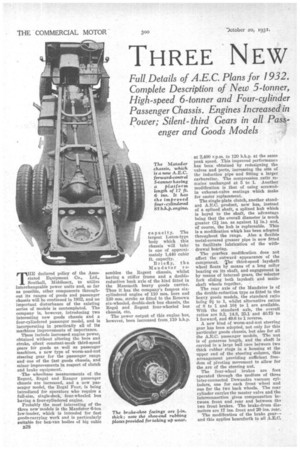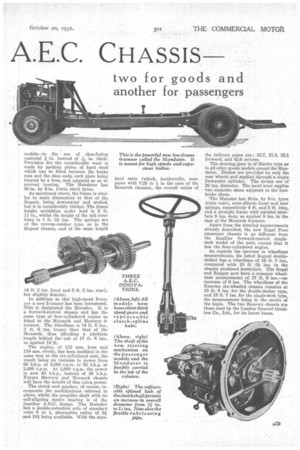THREE NEW A.E.C. CHASSIS
Page 46

Page 47

If you've noticed an error in this article please click here to report it so we can fix it.
EED declared policy of the Asso ciated Equipment Co., Ltd., Southall, Middlesex, to utilize interchangeable power units and, so far as possible, other components throughout its ranges of goods and passenger chassis will be continued in 1932, and no important disturbance of the existing series of models is contemplated. The company is, however, introducing two interesting new goods chassis and a four-cylindered passenger model, and ia incorporating in practically all of it machines improvements of importance.
These include increased engine power, obtained without altering the bore and stroke, silent constant-mesh third-speed gears for goods as well as passenger ' machiees, a new type of worm-and-nut steering gear for the passenger range and one of the fast goods chassis, and minor improvements in respect of clutch and brake equipment.
The wheelbase measurements of the Regent, Regal and Ranger passenger chassis are increased, and a new passenger model, the Regal Four, is being introduced for operators who require a full-size, single-deck, four-wheeled bus having a four-cylindered engine.
Probably the most interesting of the three new models is the Mandator 6-ton low-loader, which is intended for fast goods-carrying work and is particularly suitable for box-van bodies of big cubic capacity. The .■ largest Luton-type body which this chassis will take is one of approximately 1,440 cubic ft. capacity.
Briefly, the Mandator resembles the Regent chassis, whilst having a stiffer frame and a doublereduction back axle of the kind fitted in the Mammoth heavy goods carrier. Thus it has the company's famous sixcylindered engine of 110 mm. Lore and 130 mm. stroke as fitted to the Renown six-wheeled, double-deck bus chassis, the Regal and Regent four-wheeled bus chassis, etc.
The power output of this engine has, however, been increased from 10 b.h.p. at 2,400 r.p.m. to 120 bap, at the same peak speed. This improved performance has been obtained by redesigning the valves and ports, increasing the size of the induction pipe and fitting a larger carburetter. The compression ratio remains unchanged at 5 to 1. Another modification is that of using screwedin exhaust-valve seatings which make for easier replacement.
The single-plate clutch, another standard A.E.C. product, now has, instead of a splined shaft, a splined hub which is keyed to the shaft, the advantage being that the overall diameter is much greater (21 ins, as against 1a in.) and, of course, the hub is replaceable. This is a modification whigh has been adopted throughout the range. Also a flexible metal-covered greaser pipe is now fitted to facilitate lubrication of the withdrawal bearing.
The gearbox modification does not affect the outward appearance of the
component. he third-speed layshaft wheel floats by means of a long roller bearing on its shaft, and engagement is by means of internal gears, the selector fork sliding both layshaft and mainshaft wheels together.
The rear axle of the Mandator is of the double-reduction type as fitted in the heavy goods models, the standard ratio being 91 to 1, whilst alternative ratios of 8 to 1 and 10i to 1 are available. With the standard axle, the overall ratios are 0.3, 14.8, 25.1 and 40.75 to 3. forward, and 49.6 to 1 reverse.
A new kind of worm-and-nut steering gear has been adopted, not only for this particular goods chassis, but also for all the A.E.C. passenger models. The nut is of generous length, and the shaft is carried in a large ball race between two thick rubber rings in a housing at the upper end of the steering .column, this arrangement providing sufficient freedom of pivoting movement to allow for the arc of the steering nut.
The four-wheel brakes are foot operated through the medium of three inter-connected Dewandre vacuum cylinders, one for each front wheel and one for the two back wheels. The rear cylinder carries the master valve and the interconnection gives compensation between front and rear and between the two front brakes. The brake-drum diameters are 17 ins, front and 20 ins. rear.
The modification of the brake gear-and this applies henceforth to all A.E.C.
models—is the use of shoe-facing material / in. instead of 776in. thick. Provision for the considerable wear is made by packing plates of hard steel which can be fitted between the brake cam and the shoe ends, each plate being located by a boss, and spigoted so as to prevent turning. The Mandator has 40-in. by 8-in. (twin rear) tyres.
As mentioned above, the frame is similar in main dimensions to that of the Regent, being downswept and arched, but it is considerably thicker. The frame height amidships under load is 2 ft. lj in., whilst the height of the tail overhang is 1 ft. 3i ins. The springs are of the reverse-camber type, as in the Regent chassis, and of the same length (4 ft. 2 ins, front and 5 ft. 2 ins, rear), but slightly heavier.
In addition to this high-speed 6-tonnet a new 5-tonner has beep introduced. This is designated the Matador. It is a forward-control chassis and has the same type of four-eylindered engine as fitted to the Monarch and Mercury 4tonners. The wheelbase is 14 ft. 6 ins., 2 ft. 6 ins longer than that of the Monarch, thus affording a platform length behind the' cab of 17 ft. 6 ins., as against 14 ft.
The engine, of 112 mm. bore and 130 mm. stroke, has been modified in the same way as the six-cylindered unit, the result being an increase in power from 65 b.h.p. at 2,000 r.p.m. to 85 b.h.p. at 2,400 r.p.m. At 1,000 r.p.m. the power is now 43 b.h.p., instead of 38 b.h.p. Future Mercury and Monarch chassis will have the benefit of this extra power.
• The clutch and gearbox, of course, incorporate the modifications referred to above, whilst the propeller shaft with its self-aligning centre bearing is of the familiar A.E.C. design. The Matador has a double-reduction axle of standard ratio 8 to 1, alternative ratios of 9/ and 10/ being available. With the stau
dard ratio (which, incidentally, compares with 7.25 to 1 in the case of the Monarch chassis), the overall ratios of
the indirect gears are : 12.7, 21.5, 35.1 forward, and 42.6 reverse.
The steering gear is of Manes type as in all other goods models except the Mandator. Brakes are provided on only the rear wheels and applied through a single Dewandre cylinder. The drums are of 20 ins. diameter. The hand lever applies two'separate shoes adjacent to the footbrake shoes.
The Matador has 40-in. by 8-in. tyres (twin rear), semi-elliptic front and rear springs, respectively 4 ft. and 5 ft long, and a straight frame with parallel members 9 ins. deep, as against 8 ins, in the case of the Monarch 4Ttonner.
Apart from the detailed improvements already described, the new Regal Four passenger chassis is no different from the familiar forward-control singledeck model of the past, except that it has the four-cylindered engine.
As regards the increase in wheelbase measurements, the latest Regent doubledecker has a wheelbase of 16 ft. 3 ins., compared with 15 ft. 6:1 ins, in the chassis produced heretofore. The Regal and Ranger now have a common wheelbase measurement of 17 ft. 6 ins.—an increase of 6 ins. The wheelbase of the Renown six-wheeled chassis remains at 16 ft. 6 ins, for the double-decker type, and 18 ft. 7 ins, for the single-deck type, the measurement being to the centre of the bogie. The two Renown chassis are those used by the London General ()milbus Co., Ltd., for its latest buses.




































































































